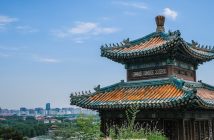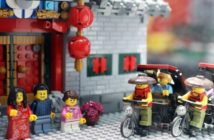Last year, the Forbidden City celebrated its 600th anniversary. 24 emperors across two dynasties – the Ming and the Qing – called it home, and since the very first day of its construction, this iconic structure has stood as the central axis of Beijing. In fact, given that the grounds are symmetrical, from a birds-eye view, that central axis forms the Chinese character 中 zhōng – 中国的中 zhōng guó de zhōng.
 It was long believed that there are 9,999.5 rooms in the Forbidden City, as there are 10,000 rooms in the celestial Palace of Heaven, meaning the number of rooms in the mortal world would be slightly less. However, after a team of experts actually undertook the task of counting all the dwellings, there turned out to be 9,371. Still not too shabby for one Emperor, don’t you think?
It was long believed that there are 9,999.5 rooms in the Forbidden City, as there are 10,000 rooms in the celestial Palace of Heaven, meaning the number of rooms in the mortal world would be slightly less. However, after a team of experts actually undertook the task of counting all the dwellings, there turned out to be 9,371. Still not too shabby for one Emperor, don’t you think?
Staff spent seven years counting all the exhibits and artefacts, and in doing so, discovered that Emperor Qianlong alone wrote 45,000 poems.
Every palace (殿 diàn) has the clay creatures called 脊兽 jǐ shòu on top of its eaves, which signifies the importance of that structure. With each bearing between one and ten 脊兽 jǐ shòu, throughout the entirety of the Forbidden City, only one has ten – Taihe Palace (太和殿 tài hé diàn) – where various ceremonies took place over the years, albeit a select few.
If you’re Chinese, then you’re probably familiar with the popular documentary, 我在故宫修文物 (wǒ zài gù gōng xiū wén wù) Masters in Forbidden City, which details how staff – most of whom graduated from top art universities in China – restore many of the fixtures and features inside the palatial complex, from wooden articles and ceramics to timepieces, calligraphy, and textiles. At its heart, the documentary reveals just how much work and creativity are required to keep things looking as they did 600 years ago. For instance, restoring a knife requires three years, while a painting can take upwards of 18. Of the laborious processes, Mr. Wang, the foreman of timepiece restoration explains, “If you really can’t sit still [for these jobs], then you need to find a new one.”
 Apart from the majestic and grandiose buildings, there’s also a delightful community of cats at the Forbidden City, who have prowled its corners and rooftops since the beginning. People believe these cats are the descendants of royal cats kept by the nobility who once called the palace home, and who are charged with protecting the fragile wooden furniture and other exhibits from mischievous mice. Every day, cat lovers from all over China donate food, so they never go hungry. What’s more, these cats also have names like 鳌拜 Áo bài, 乌拉那拉. 二花 Wū lā nà lā èr huā. Keep an eye out for these “Forbidden” felines on your next visit!
Apart from the majestic and grandiose buildings, there’s also a delightful community of cats at the Forbidden City, who have prowled its corners and rooftops since the beginning. People believe these cats are the descendants of royal cats kept by the nobility who once called the palace home, and who are charged with protecting the fragile wooden furniture and other exhibits from mischievous mice. Every day, cat lovers from all over China donate food, so they never go hungry. What’s more, these cats also have names like 鳌拜 Áo bài, 乌拉那拉. 二花 Wū lā nà lā èr huā. Keep an eye out for these “Forbidden” felines on your next visit!
 Lastly, there’s a gigantic water vat in front of the palace that was meant to prevent fires. An interesting but regrettable story is that when the Eight-Nation Alliance invaded the Forbidden City, they intended to carry the Taiping water vat with them, however, because it was too heavy to move, they used knives to scratch out the gold covering its surface. As such, today, the Taiping water vat is scratched and scarred with the memories of this unfortunate period in history.
Lastly, there’s a gigantic water vat in front of the palace that was meant to prevent fires. An interesting but regrettable story is that when the Eight-Nation Alliance invaded the Forbidden City, they intended to carry the Taiping water vat with them, however, because it was too heavy to move, they used knives to scratch out the gold covering its surface. As such, today, the Taiping water vat is scratched and scarred with the memories of this unfortunate period in history.
I once read an article that seems to grow truer and truer the older I get. It said that there have always been two Forbidden Cities, one political and one historical. The latter belongs to the Chinese people and, for all intents and purposes, it’s their Forbidden City. It’s a city that possesses Chinese values. It’s more than a symbolic scenic spot, it’s the continuation and inheritance of Chinese culture.
KEEP READING: The Woman, the Myth, the Legend Behind the Great Wall
Images: Rachel Bu, Pexels




